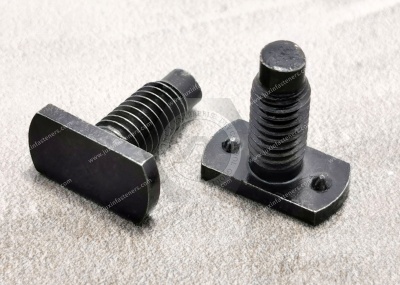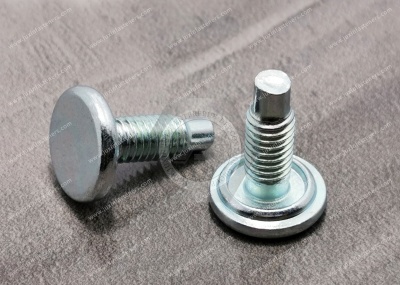Call Us
+86 136 6007 9809
Call Us
+86 136 6007 9809
Jun. 09, 2024
Application of stud welding in the body welding process Industry Solutions
Stud welding is a new welding process adapted to the development trend of welding technology. This highly efficient welding process can ensure the quality of welded parts, realize full cross-section welding, and achieve standardized operation. Integrating stud welding technology in car body welding is of great significance.
Keywords: stud welding; automobile body; welding process; application
Preface: The level of the automobile body welding process directly determines the safety performance and sealing performance of the automobile body.
Integrating the stud welding process into the auto body is a game-changer, enhancing work efficiency and delivering high-quality welding. This underscores the crucial need for construction personnel to comprehensively understand the relevant welding knowledge, empowering them to execute superior plate welding. The advent of welding technology has catalyzed the rapid advancement of automotive technology. For high-quality carbon steel flange welding studs fasteners and professional technical support, don't hesitate to contact us at adelajonly@gmail.com or visit our website at [Juxin Fasteners]: https://www.juxinfasteners.com.


1 Overview of Stud Welding: Stud welding is used to make the surface of the steel plate come into contact with the end of the stud using an electric arc. After the surface is completely melted, increase the pressure of the stud to complete the welding successfully. Stud welding belongs to the pressure welding method, which has the characteristics of both fusion welding and pressure welding, combining the dual attributes of arc welding and pressure welding. In welding, the stud welder, according to its use of different principles, can be divided into two kinds: arc stud welder and energy storage stud welder. The arc stud welder comprises a welding power source and torch. Combined with the arc stud welding cycle, it is divided into long-cycle and short-cycle stud welding. Many welding methods are currently used in the automotive industry, such as short-cycle arc stud welding with an inverter power supply.
2 Advantages of stud welding
2.1 Economic Advantages of Stud Welding: Stud welding is efficient not only in terms of welding quality but also in terms of its economic benefits. It significantly reduces the material scrapping rate, thereby maximizing the financial benefits of welding. The diversification of the type of stud welding gun further enhances its monetary value, making it a cost-effective choice for welding processes.
Low-cost gun heads and tools characterize the range of stud welding gun types. Studying welding can improve the economy and reduce the investment of funds and resources in body welding.
2.2 Design Structure Space Advantage: Stud welding has a small melting depth, short welding time, and large welding current, making it suitable for welding thin plates. The joint strength of the stud welding machine is relatively large, allowing for the expansion of the design structure of the stud welding space. In other words, stud welding can create strong joints in thin materials, increasing design possibilities and flexibility in various applications.
2.3 The high efficiency of stud welding: stud welding, compared with other welding processes, is high efficiency, low cost, short welding time, and simple structure process. In welding, there is no need to drill holes or do other high-precision work, which can save a lot of time and labor. In addition, the control parts of stud welding are not easily deformed.
3 The working principle of stud welding: The type of stud welding is more and more colorful and diversified. The working method of stud welding is also diversified. A thyristor often controls the rectifier of the stud welding machine. Along with technological development, people gradually started using inverter transformers to operate the control stud welder. The existing arc stud welder was used in the process; welding studs were clamped to the gun seat, and contact with the control device was made. The stud rises and separates from the weld control through the magnetic force in the gun. At the same time, a gravity arc is applied to the stud, creating an arc between the control and the stud, where the surface of the control will fuse to the end face of the stud. When the stud reaches the appropriate height and the welding time reaches the standard limit, the power supply must be cut off, and the welding is completed under pressure.
4. Body welding process on the specific application of stud welding
4.1 The choice of welding mode should be based on the type of vehicle selection welding mode; usually, the short-cycle arc-pulling kind of welding method is more used in the vehicle selection needs. This welding mode has the advantages of being fast, having no deformation, convenience, etc., welding position is not restricted, and various positions can be welded. Welded products have high sealing performance and will not cause air leakage, water leakage, or other issues; using stud welding metal plates instead of the traditional brazing, resistance welding, and other processes can reduce the use of nuts and other parts and low cost. In addition, short-term arc stud welding welding efficiency is high and reliable.
Currently, stud welding is mainly used to fix lines and pipes in some cars and minivans, mainly in the bottom plate, longitudinal beams, and side walls.
4.2 Setting the welding parameters of stud welding: Welding time, welding current, buffer zone, lifting height, and stud welding protruding length all belong to the category of welding parameters. The stud's protruding length and lifting height are essential parameters in welding. Once the lifting height of the stud is unreasonable, there will be a porosity weld, affecting the stability and firmness of the weld. The protrusion length determines the shaping of the weld. The depth of stud insertion influences the movement of liquid metal in the molten pool. Once the stud is inserted too deep, the liquid metal in the molten pool will move upward, thus preventing the stud from moving downward. To avoid this problem, the
Workers need to select the stud according to the size of the stud diameter. In different welding parts, some of the surface layers of the workpiece will change, resulting in a galvanized coating. At this time, the best and most reasonable parameters should be explored through experiments to prevent changes in the workpiece from affecting the welding quality. Short-cycle welding parameters should be combined with the workpiece's thickness and the torch's actual situation to choose from.
4.3 Strengthen the control of the welding process: The stud welding process is more straightforward in short cycle mode.
(1) The stud is in contact with the workpiece;
(2) The surface of the workpiece lifts the stud to a certain height and then ignites the welding arc;
(3) The arc melts the tip of the stud;
(4) The stud is pressed into the molten pool on the workpiece, and the welding is completed when the metal is completely solidified.
The above is the stud welding process; relatively simple answer, but you still need to make the relevant preparations before welding, screw the stud collet on the torch stud, and adjust the leg combination so that the stud is concentric with the support tube. When tightening the hexagonal screw, adjust the support rod so that the length of the stud extends to meet the requirements, and change the lifting height of the position of the rear cover of the welding gun to ensure the reliability of the connection between the welding power source and the power grid. When welding, the device should be aligned with the specific welding position to ensure that the workpiece is in close contact with the support sleeve and the workpiece is perpendicular to the welding gun. The welding projection length is correct, and the studs are welded to the workpiece per the welding requirements.
5. Problems to be noted when using stud welding
5.1 The following issues need to be noted during the stud welding process. First, before stud welding, the welding cable should be inspected to ensure that the current and voltage of the stud welding are sufficient and stable. Select the appropriate type, material, and type of stud;
5.2 When welding, it's crucial for the welding technician to adjust the angle between the welding torch and the plate, and the operating angle should be controlled at 90 degrees ° to ensure the welding quality. The technician's regular checks on the welding machine, maintenance, and repair are vital to prevent equipment failure caused by a series of problems. The selection of high-quality professional welding personnel skilled in equipment operation is essential to mastering the welding support and process. The relevant units should also regularly organize welding technicians to participate in welding-related training so that the stud welding process and automotive technology technicians can develop a far-reaching vision and an excellent professional attitude while strengthening their safety awareness and ensuring their safety in the work area.
5.3 Welding results check: strictly control the welding quality. You can use the hammering and appearance inspection methods to check and maintain the quality of the weld.
With the rapid development of modern science and technology, stud welding process technology has made significant strides. It is now widely used in the welding process of vehicles, enhancing the quality of automobiles, improving automobile airtightness, and effectively solving the problem of automobile and water leakage. This technology is cost-effective and efficient and has a short use time. As body technology continues to evolve, stud welding is set to move towards intelligentization and automation, opening up new possibilities and exciting prospects for the future of vehicle manufacturing.
Contact Us
Tel.:
+86 020 8621 0320
+86 020 3121 6067
Technical Support:
Navigation
SEND INQUIREY